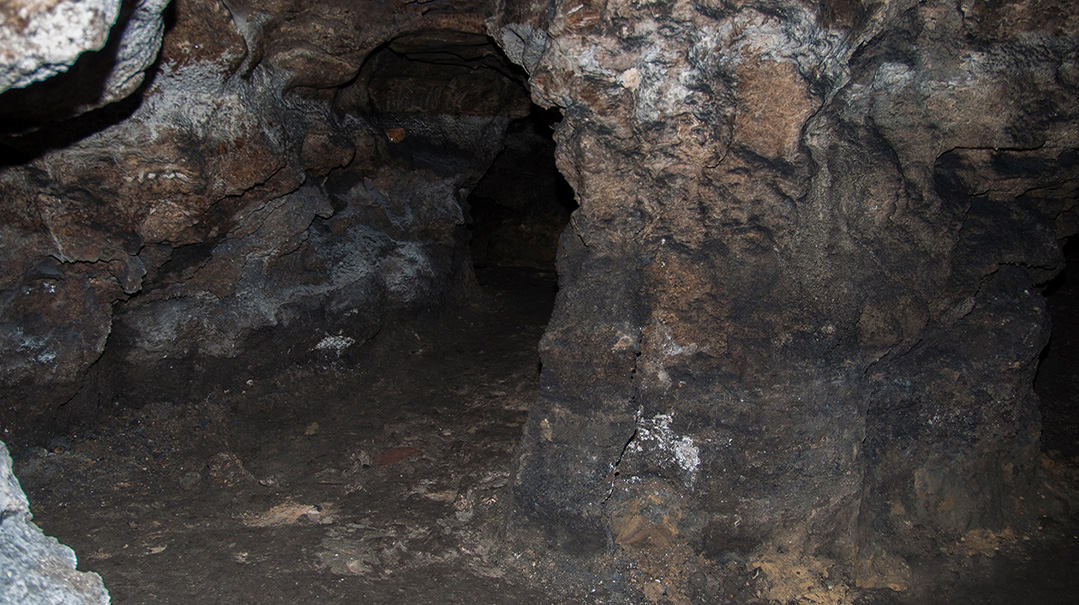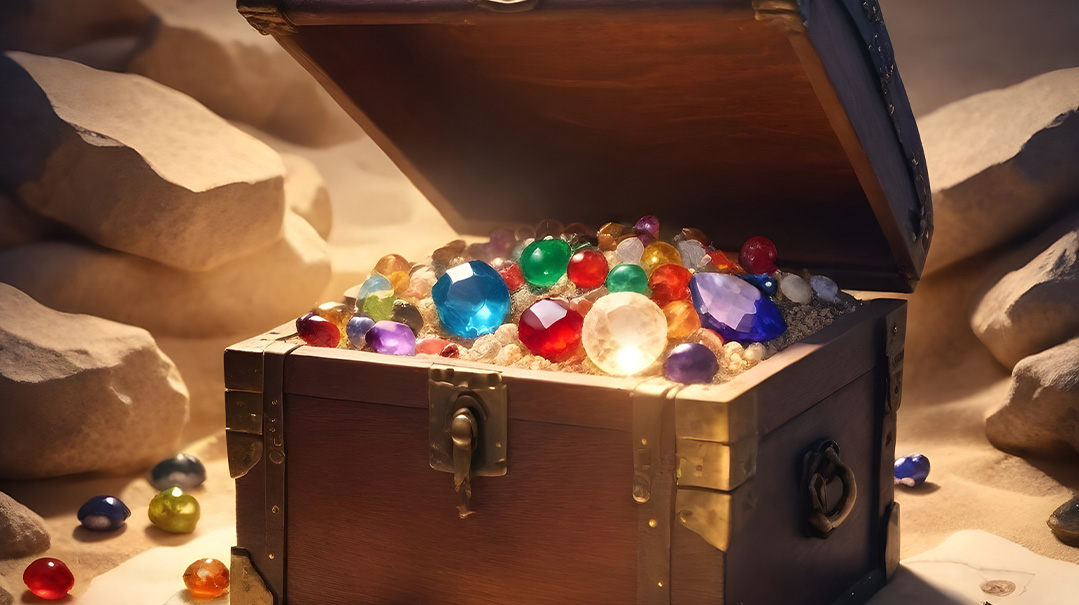Hidden Miracles
| December 5, 2023A group of Jewish families created a home for themselves deep inside caves to escape the Nazis

Jews hiding from their enemies in caves?
We’ve heard all about it from the story of Chanukah. But who would’ve thought it could happen as recently as during the time when our great-grandparents were young? Less than a hundred years ago, a group of Jewish families created a home for themselves deep inside caves to escape the Nazis. This is their story.
IT’Sbeen a rough few years in Korolivka, Ukraine. The Jewish community here is large and bustling — 500 families, almost half the village! There are two shuls and a cheder in the neighborhood. Esther Stermer lives in a big, comfortable house with her husband, Shabsy, six children, and all of her grandchildren.
But there are bad times coming. In 1939, Esther hears about the terrible things that Hitler and his Nazis are doing to the Jews in Poland. The Nazis from Germany have made a deal with the Russians to split up the land between them. Ukraine is supposed to go to the Russians, but Hitler double-crosses them and takes over the country. A new ghetto will be built, and all the Jews are ordered to go there.
Esther and her family don’t go into the ghetto. Instead, they dig a secret bunker under their house and hide in it whenever the Germans come. The Nazis control the land, but they don’t keep a close eye on her neighborhood, and her family hides whenever they come into the village. Esther’s clever three-year-old granddaughter, Sima, asks her, “How come the dog and the chickens can walk around freely, but not me?”
IN1942, a new order comes. “All Jews in Korolivka must move into the ghetto!” It doesn’t matter who you are or where you live. If you are Jewish, you have to live in the tight, cramped space.
Esther knows she has to find somewhere else that’s safer for her family. Her husband and her oldest son, Nissen, start looking for a hideout. A Jewish doctor in a nearby village has an idea. “What about Verteba Cave?”
Esther knows Verteba Cave. She remembers learning about it in school, about artifacts from people who had lived there. Loads of tourists used to come to see it before the war. It’s full of strange-looking stalactites and stalagmites, mounds of minerals that either grow from the top or the bottom or a cave, and it’s so big that there are maps that outline the whole area. The maze-like tunnels that run through it are called streets, and it’d be hard for intruders to find anyone if the escapees were deep enough in the cave. As the cold winter begins, the family decides to take the chance and move in.
To get into the cave, Esther has to slide through its narrow opening to get down. The families carry ropes, tying them to stalagmites in one area so they’ll be able to find their way back. Little by little, the Stermers and the other Jewish families figure out how to get around.
There are almost 30 people in the cave. Some of them are little kids like Sima, who read poems and play together. The Jews work to make the cave feel like home. They build wooden beds and tables in one cavern, and one dentist even creates a work station!
Several challenges came up for the Jews that they must figure out together. First, there’s the issue of how they will light up their dark surroundings. They bring candles, but they run out of them quickly. Soon, some of the people in the cave figure out how to make little bottles of oil to light with a wick to make it brighter.
Another important need for everyone is finding food. Esther and her companions sleep during the day so they won’t make a lot of noise. Each family picks someone to sneak out at night and get food from the village. Nissen and Shabsy are chosen from Esther’s family, and they collect fruits and vegetables from nearby farms, bringing them back for everyone to share. They even get a tin stove for families to cook on!
There’s another problem: How will they find water? Melting snow gives Esther and the others some water. They also notice that water drips down the sides of the cave and down the stalactites hanging from the ceiling. They catch it in small bottles and pots and drink it, though it’s never really enough.
Also, there’s the problem of unwanted cave creatures. Sometimes there are bats that swoop down and make the kids shriek, and there are foxes that Esther has to chase away from the food. “Out! Find your own food!”
Despite the challenges, they feel safe. They’re relieved to be safe from the Nazis, at least for the time being.
But as winter starts to change to spring,
the cavers get worried. “If it gets warmer, tourists might come back to see the caves. We have to go in deeper.” They work together to dig a new exit, a way to escape in case they’re found. This way, the Nazis won’t be able to block the entrance and lock them inside.
They soon find out that it was the best idea they’d had yet! Shortly after they build the second exit, a German is walking near the cave entrance when he spots some potatoes that someone had dropped. “There are Jews in here!” he says, and runs to tell the Nazis.
One day in April, the hidden Jews wake up to shouting in German. “We found the place! We found the place!” The Jews all flee together to the deepest part of the cave.
The Nazis stalk through the tunnels, speaking loudly to each other. Esther is caught, but she speaks bravely to the Nazis. “Catching us won’t win the war,” she says. “Look at how we’re living. Leave us here.” Then she runs. They chase her, but they don’t catch her.
When she rejoins the other Jews in the caves, she finds her son, Saul, lying there in shock. She exits the cave, now that it is no longer safe, and carries him for miles through the wilderness, the wind and the rain pounding against her face, until they’re finally taken in by a friendly farmer.
The Nazis send the local police to search the cave again. By then, all they can find are the possessions that the cavers left behind. Everyone has gotten out through the second exit. The cave-dwellers race through the wilderness in different directions. For weeks, they roam near the Seret River, hiding in old underground bunkers and in barns and with friends. Soon, there are even more of them hiding together than there had been at first.
Eventually, one of Nissen’s friends tells him about a new cave. It looks tiny from the outside, so small that everyone has to slide in feet-first. Inside, the cave is pitch black and small. Nissen crawls deeper through a tunnel that is deep and narrow, the walls closing in around him. But soon, the tunnel opens up to a huge hall, so high that he can hardly see the ceiling. Beyond it is a big, spacious tunnel — and lakes full of water for drinking! No one has been here before. The cave is perfect.
On May 5, 1943, a larger group of Jews leave for the new cave, now called Priest’s Grotto. They bring furniture and pillows and blankets along with supplies. The large tunnel is going to be their new home, and each family picks one section to sleep in. Esther and the others choose a spot for cooking far away from where everyone sleeps so that no one will choke on the fumes from the stove, and the lakes are great both for water and staying clean. They can even wash their clothes!
But they still need wood and food from outside. Once in a while, some of them sneak out to get supplies — either buying it from friendly farmers or stealing from people who had cheated the Jews in the past. Saul builds a wooden sleigh and Nissen makes Esther a wooden spinning wheel that can turn flax seeds into the fabric linen. The Stermer brothers even bring in a hundred-pound millstone and build a mill so the families can grind grain into flour for bread.
After a few months, some of the peasants figure out that there are Jews in the cave. They can’t squeeze into the cave without the cavers stopping them, so they fill the entrance with dirt instead to trap the families inside.
But Esther, her family, and her fellow cavers are prepared. The cavers dig a new exit, far from the original entrance, and hide it with leaves and rocks, blocking it from the inside. From then on, they only exit the cave to get more food and supplies when everyone is desperate, and they bring enough to keep everyone safe for months to come.
Before the farmers outside harvest their crops, Saul Stermer and a group of others race out at night, collecting tons of potatoes, corn, and other vegetables. They pile the potatoes high and hang the corn to dry. Soon, the cavers are able to grind the corn into flour and make porridge. This bowl of porridge tastes better than the most delicious food I’ve ever tasted, Esther thinks.
Everyone in the cave has a different job.
Esther watches the moon, tracking its cycle so they can go out only on the darkest nights. It also helps them keep track of Yamim Tovim. They have a siddur in the cave — one that’s shared between everyone for Yom Tov. All of the adults fast on Yom Kippur and one of Esther’s sons leads a full, meaningful davening. Like the ancient Jews during the story of Chanukah, the cavers are hiding themselves to keep the Torah.
It’s April of 1944, a full year after they escaped the first cave, when something changes. A Jewish boy appears in the fields during one nighttime mission and passes on the amazing news. The war is over, at least in this part of Ukraine. The Jews are finally free.
When the cavers make it out
of the cave, everything feels new and strange. The bright light of the sun hurts. It feels like pins stuck in their eyes. As they walk through the streets, the local villagers gape at them in surprise. One even offers them cookies. They didn’t know that any Jews were still alive in the village — though there are many more, the cavers will discover soon, who hid in the underground shelters or on farms or in the forest, and who will come out over the next few weeks.
After the war, the Stermers and their family move to Poland, then Germany, then finally to North America. Esther writes a book about her experiences, but not many people read it. No one really knows about the cavers except for the families themselves. In fact, when they do share their story, even some of the other Jews don’t believe it. They think that the cavers have lost their minds.
But then, in the late 1960s, a boy and his friends go into the Verteba Cave to explore, and find old shoes, empty medicine bottles, utensils, and burnt wood. It seems like people had once camped there for a long time. The boy even sees unfamiliar letters on the cave walls in an alphabet he’s never seen before. He asks his parents about it, but all they know is that Jews once hid in the cave during World War II.
Thirty years later, in 1993, a former New York police detective travels to Ukraine to learn more about his own family and to see the caves. While exploring Priest’s Grotto, he finds a large gallery. Inside are shoes, bottles, buttons, and clothing. He tries to find out more about it, but none of the locals want to speak to him. For nine years, he investigates and writes articles about his research. And then, finally, he gets an email from a man named Sol Wexler, who lives only seven miles away from him in New York. He is one of the original cavers who had spent 511 days in the caves during the Holocaust.
In 2010, a group of the cavers return to both caves with their families and the police detective. Now, even the youngest of them are elderly, and they explore the caves and say Kaddish there. In Verteba Cave, the cavers see their own family names written in Polish on the wall. Why had one of the cavers written them in Polish, not Yiddish? One caver explains their reasoning to the detective in 2007: “If we didn’t get out, the world would know that we were there.” They had wanted their story to be heard.
Squizzle Talks about Speaking in Codes
When in hiding, there are loads of ways to secretly talk to each other. Here are just a few:
Have you ever tried spelling something for someone else? S sounds like F and B sounds like D, and soon, it’s a mess of spelling mistakes. Armies use the NATO phonetic alphabet so each letter is clear. Can you figure out what Charlie Hotel Alfa November Uniform Kilo Alfa Hotel might say?
During World War II, the army used a group of Native American Navajos to create a code based on their language. So few people knew their language that the code talkers could use it to pass on messages without worrying about being heard.
Morse code was invented for telegraphs, an early way to send messages. Each letter was represented by dashes and dots — a long or short beep. During the Vietnam War, one prisoner, Jeremiah Denton, was given a script to follow for a video. But as he spoke, he blinked out a secret message in Morse code. The most famous phrase in Morse code is three short signals, followed by three long, followed by three short again: It spells SOS, or “send help.”
Julius Caesar used a special system to encode his messages: He would substitute each letter of the alphabet for one that was a certain number of letters away. If the key is each letter represents one four letters before, what does HSYKLRYXW EVI HIPMGMSYW say?
(Originally featured in Treeo, Issue 989)
Oops! We could not locate your form.







